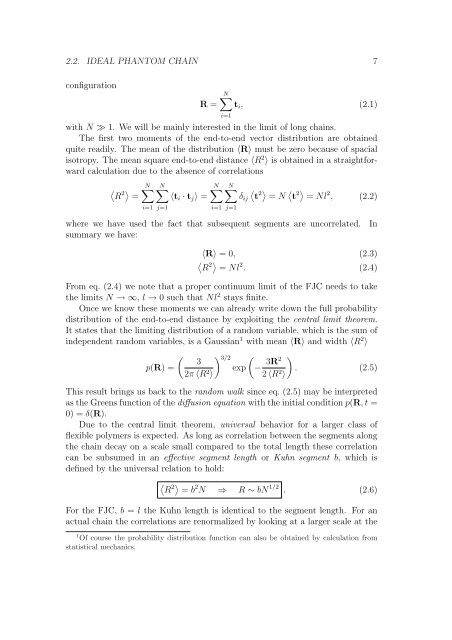Polymers in Confined Geometry.pdf
Polymers in Confined Geometry.pdf
Polymers in Confined Geometry.pdf
You also want an ePaper? Increase the reach of your titles
YUMPU automatically turns print PDFs into web optimized ePapers that Google loves.
2.2. IDEAL PHANTOM CHAIN 7<br />
configuration<br />
R =<br />
N<br />
ti, (2.1)<br />
i=1<br />
with N ≫ 1. We will be ma<strong>in</strong>ly <strong>in</strong>terested <strong>in</strong> the limit of long cha<strong>in</strong>s.<br />
The first two moments of the end-to-end vector distribution are obta<strong>in</strong>ed<br />
quite readily. The mean of the distribution 〈R〉 must be zero because of spacial<br />
isotropy. The mean square end-to-end distance 〈R 2 〉 is obta<strong>in</strong>ed <strong>in</strong> a straightforward<br />
calculation due to the absence of correlations<br />
R 2 =<br />
N<br />
i=1<br />
N<br />
〈ti · tj〉 =<br />
j=1<br />
N<br />
i=1<br />
N<br />
j=1<br />
δij<br />
t 2 = N t 2 = Nl 2 , (2.2)<br />
where we have used the fact that subsequent segments are uncorrelated. In<br />
summary we have:<br />
〈R〉 = 0, (2.3)<br />
R 2 = Nl 2 . (2.4)<br />
From eq. (2.4) we note that a proper cont<strong>in</strong>uum limit of the FJC needs to take<br />
the limits N → ∞, l → 0 such that Nl 2 stays f<strong>in</strong>ite.<br />
Once we know these moments we can already write down the full probability<br />
distribution of the end-to-end distance by exploit<strong>in</strong>g the central limit theorem.<br />
It states that the limit<strong>in</strong>g distribution of a random variable, which is the sum of<br />
<strong>in</strong>dependent random variables, is a Gaussian 1 with mean 〈R〉 and width 〈R 2 〉<br />
p(R) =<br />
<br />
3<br />
2π 〈R2 3/2 <br />
exp −<br />
〉<br />
3R2<br />
2 〈R2 <br />
. (2.5)<br />
〉<br />
This result br<strong>in</strong>gs us back to the random walk s<strong>in</strong>ce eq. (2.5) may be <strong>in</strong>terpreted<br />
as the Greens function of the diffusion equation with the <strong>in</strong>itial condition p(R, t =<br />
0) = δ(R).<br />
Due to the central limit theorem, universal behavior for a larger class of<br />
flexible polymers is expected. As long as correlation between the segments along<br />
the cha<strong>in</strong> decay on a scale small compared to the total length these correlation<br />
can be subsumed <strong>in</strong> an effective segment length or Kuhn segment b, which is<br />
def<strong>in</strong>ed by the universal relation to hold:<br />
R 2 = b 2 N ⇒ R ∼ bN 1/2 . (2.6)<br />
For the FJC, b = l the Kuhn length is identical to the segment length. For an<br />
actual cha<strong>in</strong> the correlations are renormalized by look<strong>in</strong>g at a larger scale at the<br />
1 Of course the probability distribution function can also be obta<strong>in</strong>ed by calculation from<br />
statistical mechanics.













